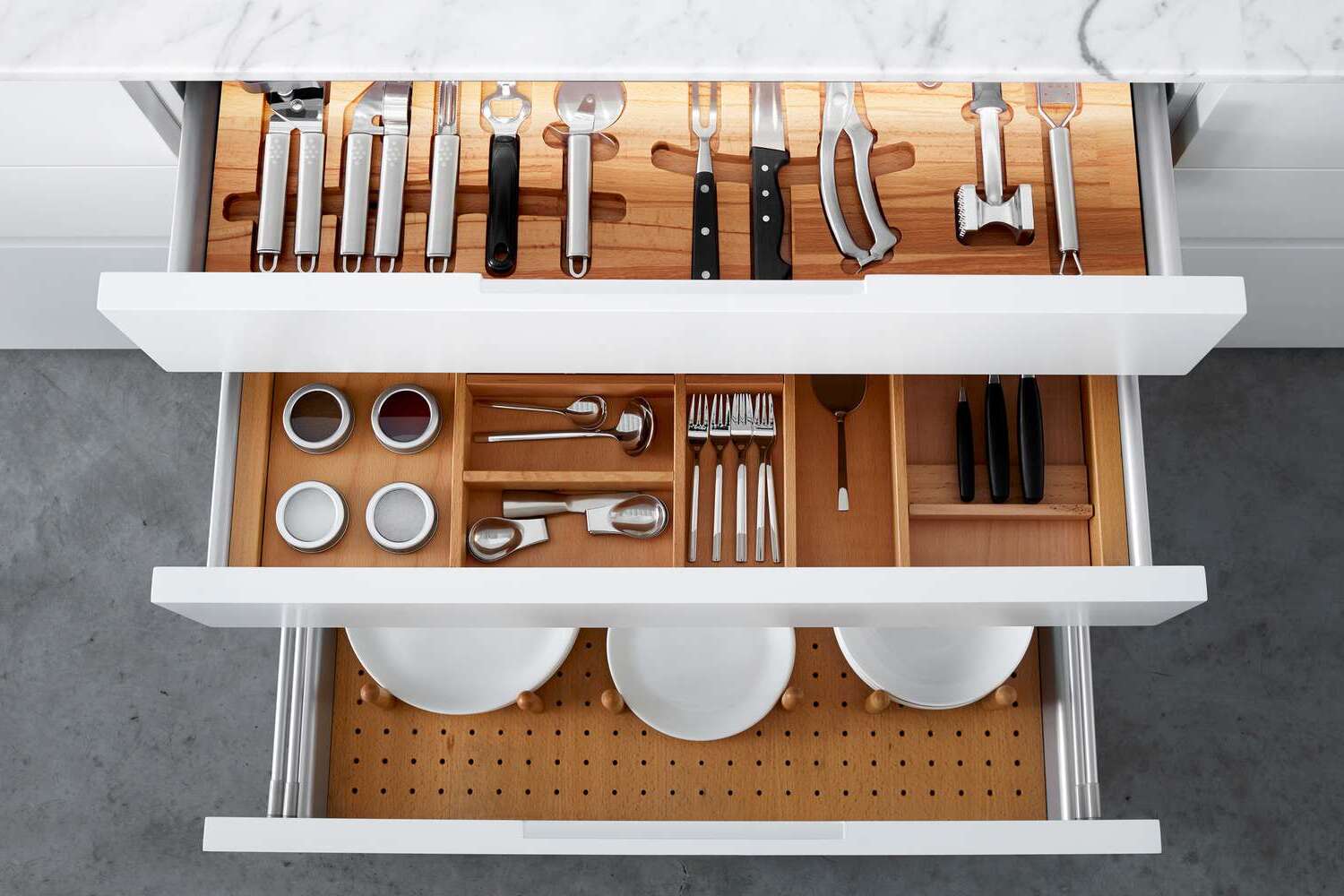Home>Ideas and Tips>Kitchen Robot Integration: Automate Your Cooking Tasks


Ideas and Tips
Kitchen Robot Integration: Automate Your Cooking Tasks
Modified: October 28, 2024
Discover how kitchen robots can automate your cooking tasks, saving you time and ensuring precision. Explore types, benefits, and practical applications.
(Many of the links in this article redirect to a specific reviewed product. Your purchase of these products through affiliate links helps to generate commission for Storables.com, at no extra cost. Learn more)
What is a Kitchen Robot?
A kitchen robot is a sophisticated device that combines hardware and software to perform culinary tasks with precision and consistency. These robots typically feature articulated arms, sensors, and sometimes AI-enabled cameras. The mechanical arms are responsible for physical actions such as chopping, stirring, and moving utensils or ingredients. The sensors and cameras gather data about the food being cooked, such as temperature or color, to determine the optimal cooking time or to adjust the cooking process.
Types of Kitchen Robots
Kitchen robots come in various forms, each designed to perform specific tasks or integrate seamlessly into existing kitchen appliances. Here are some of the most common types:
-
Standalone Units: These robots are designed for specific tasks and can be standalone units. For example, a robotic chef that can cook a variety of dishes or a salad-making robot like Sally.
-
Integrated Appliances: Some smart ovens now incorporate cooking robot technology to automate the cooking process. These integrated appliances ensure that your cooking is precise and consistent.
-
AI-Enabled Cooking Machines: These machines are trained in understanding food and general kitchen space and cooking. They can prepare ingredients, cook, and sometimes even clean with minimal human intervention.
-
Meal Prep and Batch Cooking Robots: Commercial versions of kitchen robots can perform tasks like meal prep and batch cooking. These robots are particularly useful for busy households or professional chefs.
Benefits of Kitchen Robot Integration
Integrating kitchen robots into your cooking routine offers numerous benefits, making meal preparation faster, more efficient, and enjoyable.
1. Time Efficiency
One of the primary advantages of kitchen robots is their ability to automate time-consuming tasks. Chopping vegetables, stirring ingredients, and cooking meals can be done with minimal human intervention. This saves you time that you can use for other activities or simply relax while your meal is being prepared.
2. Precision and Consistency
Kitchen robots are programmed to follow specific recipes and cooking techniques. They ensure that your meals are cooked to exact specifications, resulting in consistent flavors and textures. This precision is particularly beneficial for those who value quality in their cooking.
3. Convenience
With a kitchen robot, you can select the dish you want to cook, provide the required ingredients, and then go about your day as usual. The robot will notify you through your phone or smartwatch when your meal is ready. This convenience is especially appealing to busy households where everyone has different schedules.
4. Customization
Many advanced kitchen robots allow you to customize recipes based on your taste and dietary preferences. This feature ensures that you can enjoy a variety of meals tailored to your needs without having to manually adjust each ingredient.
5. Healthier Options
By automating meal preparation, kitchen robots can help you prepare healthier meals. For instance, they can chop vegetables precisely and cook them without adding extra oil or salt. This makes it easier to maintain a balanced diet.
Practical Applications of Kitchen Robots
Kitchen robots can be integrated into various aspects of meal preparation, from simple tasks like chopping to complex operations like meal prep and batch cooking.
1. Chopping and Mixing
One of the most basic yet essential tasks in cooking is chopping vegetables and mixing ingredients. Kitchen robots equipped with articulated arms can perform these tasks with precision and speed, reducing the time spent on manual preparation.
2. Meal Prep and Batch Cooking
Commercial versions of kitchen robots are designed for meal prep and batch cooking. These robots can prepare multiple meals simultaneously, making them ideal for large families or professional chefs who need to prepare large quantities of food.
3. Cooking and Baking
Advanced kitchen robots can perform a variety of cooking tasks, including baking. They can follow recipes, measure ingredients accurately, and even adjust cooking times based on the data gathered by sensors and cameras.
4. Cleaning Up
Some advanced models of kitchen robots also come with cleaning features. They can clean up after cooking by washing utensils, sweeping the floor, or even cleaning the countertops.
Challenges and Limitations
While kitchen robots offer numerous benefits, there are also some challenges and limitations to consider when integrating them into your kitchen.
1. Cost
One of the primary concerns is the cost of these advanced machines. Basic models that perform simple tasks like chopping or mixing are generally more affordable, but advanced models equipped with cooking, baking, and smart home integration features tend to be pricier.
2. Space and Design
Kitchen robots require space in your kitchen, which can be a challenge for smaller kitchens. However, many modern kitchen designs now incorporate space-saving solutions for these robots, ensuring they fit seamlessly into any kitchen layout.
3. Maintenance and Repair
Like any electronic device, kitchen robots require regular maintenance and occasional repairs. Ensuring that you have a reliable vendor partner who can provide excellent service and support is crucial for minimizing downtime.
4. Human Creativity and Intuition
While kitchen robots can automate many tasks, they lack the creativity and intuition that human chefs bring to cooking. Cooking involves sensory experiences, adapting to unique ingredients, and personal touches that machines cannot replicate.
Real-World Examples
Several companies are already pioneering the use of kitchen robots in both commercial and home settings.
1. Samsung Bot Chef
Samsung has introduced its Bot Chef, a robotic kitchen assistant designed to help with meal preparation. The Bot Chef can chop vegetables, stir ingredients, and even cook meals with precision and consistency.
2. Moley Robotics
Moley Robotics offers fully automated kitchen robots that can prepare a wide variety of dishes. These robots use a combination of robotic arms and advanced sensors to replicate human cooking techniques.
Read also: 8 Amazing Robot Lunch Box for 2025
3. Nymble
Nymble is a fully-automated end-to-end cooking machine designed for home use. It allows users to try over 500+ recipes, customize them according to their liking, schedule meals ahead of time, and track them from their phone.
Phased Implementation
When considering integrating kitchen robots into your kitchen, it's essential to implement the technology in phases. This approach allows you to determine what works best for your specific needs and find solutions that meet those goals.
-
Start with Simple Tasks: Begin by automating simple tasks like chopping vegetables or mixing ingredients. This will help you get accustomed to the robot's functionality and ease into more complex operations.
-
Standardize Operating Procedures: Establish strong standard operating procedures (SOPs) before implementing automation. This ensures that your food quality remains consistently great throughout the transition period.
-
Make Processes “Goof-Proof”: Make sure your processes are designed to be foolproof. This reduces the need for constant training of new hires, which can create an efficiency drag and defeat the value of your automation gains.
-
Find the Right Vendor Partner: Choose a vendor partner who will stand behind their product beyond implementation and continue providing excellent service and support over the long term.
Conclusion
Kitchen robots are revolutionizing the way we cook by automating various tasks and enhancing efficiency, precision, and convenience in the kitchen. While there are challenges and limitations to consider, the benefits of integrating these robots into your cooking routine are undeniable. Whether you're a busy household looking to save time or a professional chef seeking to streamline operations, kitchen robots offer a promising solution for modern kitchens.
In conclusion, by understanding the types of kitchen robots available, their benefits, and practical applications, you can make an informed decision about integrating these advanced machines into your home or commercial kitchen. The future of cooking is here, and it's time to explore how kitchen robots can automate your cooking tasks for a more efficient and enjoyable culinary experience.
Was this page helpful?
At Storables.com, we guarantee accurate and reliable information. Our content, validated by Expert Board Contributors, is crafted following stringent Editorial Policies. We're committed to providing you with well-researched, expert-backed insights for all your informational needs.











0 thoughts on “Kitchen Robot Integration: Automate Your Cooking Tasks”